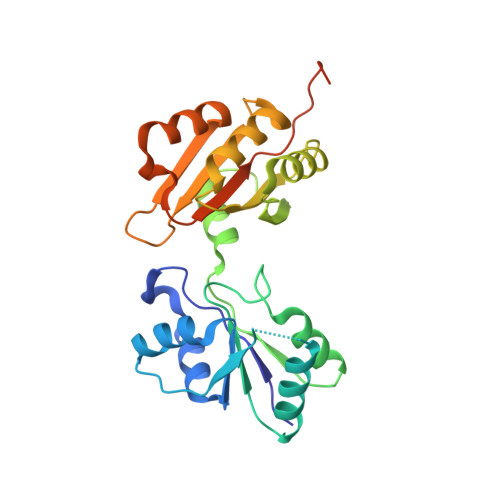Structural Insights into the Methylation of C1402 in 16S rRNA by Methyltransferase RsmI
Zhao, M., Zhang, H., Liu, G., Wang, L., Wang, J., Gao, Z., Dong, Y., Zhang, L., Gong, Y.(2016) PLoS One 11: e0163816-e0163816
- PubMed: 27711192
- DOI: https://doi.org/10.1371/journal.pone.0163816
- Primary Citation of Related Structures:
5HW4 - PubMed Abstract:
RsmI and RsmH are conserved S-Adenosylmethionine (AdoMet)-dependent methyltransferases (MTases) that are responsible for the 2'-O-methylation and N4-methylation of C1402 in bacterial 16S rRNA, respectively. Methylation of m4Cm1402 plays a role in fine-tuning the shape and functions of the P-site to increase the decoding fidelity, and was recently found to contribute to the virulence of Staphylococcus aureus in host animals. Here we report the 2.20-Å crystal structure of homodimeric RsmI from Escherichia coli in complex with the cofactor AdoMet. RsmI consists of an N-terminal putative RNA-binding domain (NTD) and a C-terminal catalytic domain (CTD) with a Rossmann-like fold, and belongs to the class III MTase family. AdoMet is specifically bound into a negatively charged deep pocket formed by both domains by making extensive contacts. Structure-based mutagenesis and isothermal titration calorimetry (ITC) assays revealed Asp100 and Ala124 are vital for AdoMet-binding. Although the overall fold of RsmI shows remarkable similarities to the characterized MTases involved in vitamin B12 biosynthesis, it exhibits a distinct charge distribution especially around the AdoMet-binding pocket because of different substrate specificity. The docking model of RsmI-AdoMet-RNA ternary complex suggested a possible base-flipping mechanism of the substrate RNA that has been observed in several known RNA MTases. Our structural and biochemical studies provide novel insights into the catalytic mechanism of C1402 methylation in 16S rRNA.
- Beijing Synchrotron Radiation Facility, Institute of High Energy Physics, Chinese Academy of Sciences, Beijing, China.
Organizational Affiliation:

















